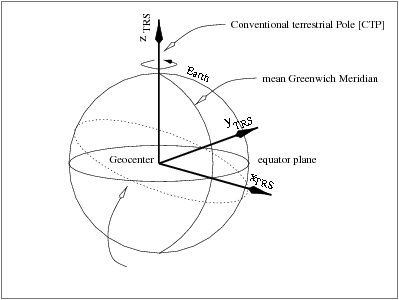If you wish to contribute or participate in the discussions about articles you are invited to contact the Editor
Conventional Terrestrial Reference System
| Fundamentals | |
|---|---|
| Title | Conventional Terrestrial Reference System |
| Author(s) | J. Sanz Subirana, J.M. Juan Zornoza and M. Hernández-Pajares, Technical University of Catalonia, Spain. |
| Level | Basic |
| Year of Publication | 2011 |
This reference system is also known as Earth-Centred, Earth-Fixed (ECEF), it is an earth-fixed, i.e. rotating (not space-fixed as CRS reference system). Its origin is the Earth's centre of mass, the fundamental plane contains this origin and it is perpendicular to the Earth's Conventional Terrestrial Pole (CTP) --defined as an average of the poles from 1900 to 1905--. Its principal axis is pointing to the intersection of the mean Greenwich meridian and the equator. Since this coordinate system follows the diurnal rotation of earth, this is not an inertial reference system.
The three axis that define this system are showed in Figure 1.
- z[math]\displaystyle{ _{TRS} }[/math]: This axis is defined by the Conventional Terrestrial Pole (CTP).
- x[math]\displaystyle{ _{TRS} }[/math]: This axis is defined as the intersection between the equatorial plane and the mean Greenwich meridian. The equatorial plane is orthogonal to the CTP and in the Mean Greenwich meridian direction. This meridian was established by the Bureau International de l'Heure (BIE) observatory.
- y[math]\displaystyle{ _{TRS} }[/math]: It is orthogonal to the formers ones, so the system is right-handed.

